The economy and efficiency of Waters’ ACQUITY APC combined with the powerful advanced GPC/SEC detectors of OMNISEC REVEAL allowed the complete characterization of the low molecular weight polystyrene and polycaprolactone samples. The individual oligomers of both samples could be observed and characterized separately due to the resolution of the APC columns and sensitivity of the OMNISEC REVEAL detectors – with standard 30 cm analytical GPC/SEC columns it is not possible to resolve the oligomers at all. The greatly reduced quantity of solvent and time required to obtain comprehensive characterization of samples using the APC-REVEAL system presents obvious benefits to both researchers and manufacturers working with polymeric materials.
Gel permeation / size exclusion chromatography (GPC/SEC) has been and remains the ideal analytical technique for analysis of polymer molecular weight. Over the years, developments in detector technology have allowed users to go from obtaining relative molecular weight by using a single concentration detector to complete molecular characterization with absolute molecular weight by adding viscometer and light scattering detectors, among others. Those detector advancements, however, were not accompanied with similar improvements to enhance resolution and reduce the column volume, sample quantity, and time required for analysis until the recent emergence of Advanced Polymer Chromatography™ (APC™). The Waters ACQUITY Advanced Polymer Chromatography (APC) system applies the advantages of Ultra-Performance Liquid Chromatography (UPLC®) to the polymer market for relative molecular weight analysis. The introduction of this product allowed for more efficient size separation to deliver relative molecular weights based on column calibration.
Recently, Malvern Panalytical introduced a version of the OMNISEC REVEAL advanced detector unit that has been optimized for use under APC conditions and, through a collaboration with Waters, has brought advanced detection to APC analysis.
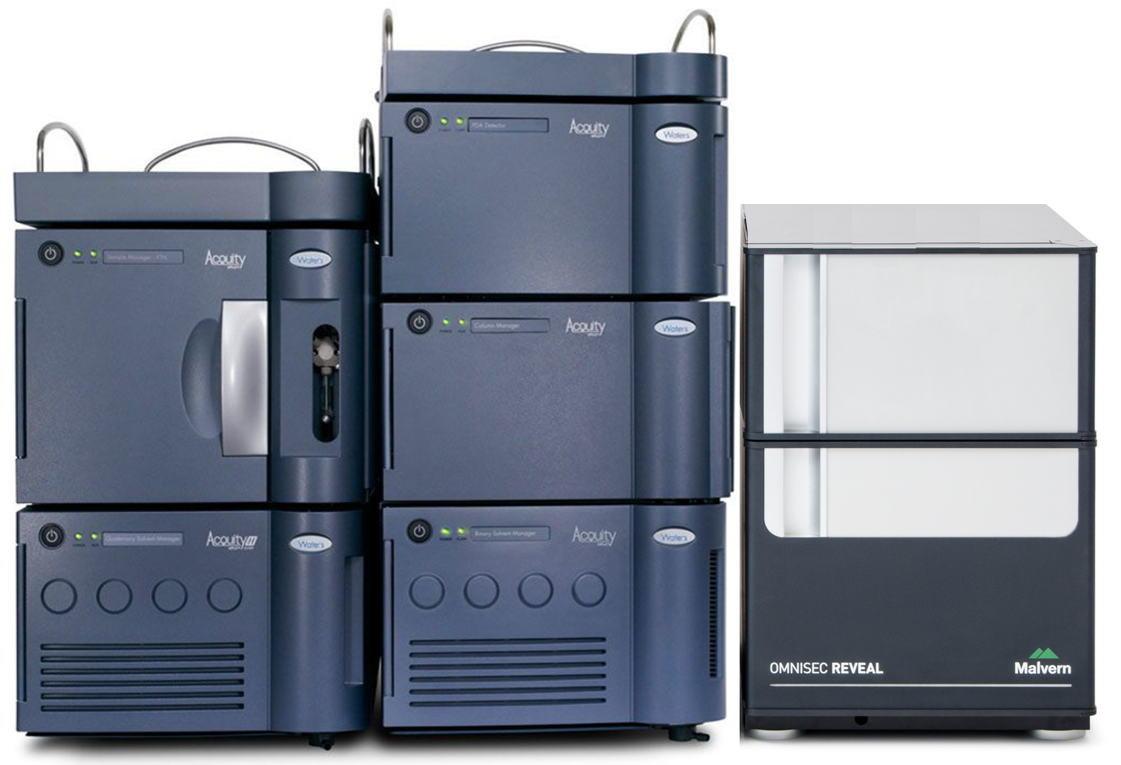
Figure 1. The ACQUITY APC from Waters and OMNISEC REVEAL from Malvern Panalytical.
One of the hallmarks of APC is excellent resolution of low molecular weight samples, and one of the features of OMNISEC REVEAL is the sensitivity of its light scattering detector, especially for low molecular weight samples. In this application note, two low molecular weight polymers, a polystyrene and a polycaprolactone, were analyzed using the OMNISEC REVEAL and Waters ACQUITY APC in combination to demonstrate the power of comprehensive characterization by multi-detection together with the speed, efficiency and resolution of APC.
One polystyrene sample and one polycaprolactone sample, both low molecular weight, were analyzed using an ACQUITY APC-REVEAL system with a mobile phase of THF. Each sample had a specific set of analysis conditions which will be detailed accordingly.
The polystyrene sample was analyzed with a flow rate of 0.8 mL/min using a set of three 150 mm ACQUITY APC columns: 45, 125, and 450 Å in series. The column and detector temperatures were set to 40 °C. The concentration of the polystyrene sample was 9.725 mg/mL, of which 20 µL injections were made. The amount of mass introduced to the system was 194.5 µg, less than a typical GPC/SEC analysis for the same low molecular weight sample which might use 300-500 µg per injection.
For comparison, the same polystyrene sample was also analyzed using two 30 cm mixed-bed analytical GPC/SEC columns. Before assessing the quality of the APC-REVEAL results, it’s worth comparing the chromatograms from the two techniques. The overlay of the refractive index samples of both analyses shown in Figure 2 makes the difference in mobile phase and analysis time required visibly obvious. While more than 20 mL of solvent are required for the sample to elute from the pair of mixed-bed analytical GPC columns, the sample elutes from three APC columns in less than 5 mL! This represents a saving both in solvent consumption (in this case, 15 mL) and time for analysis (in this case, ~19 mins) per analysis. Most importantly, the high resolution provided by the set of APC columns afforded this sophisticated analysis for various oligomers that were not separated on the standard 30 cm analytical GPC/SEC columns.
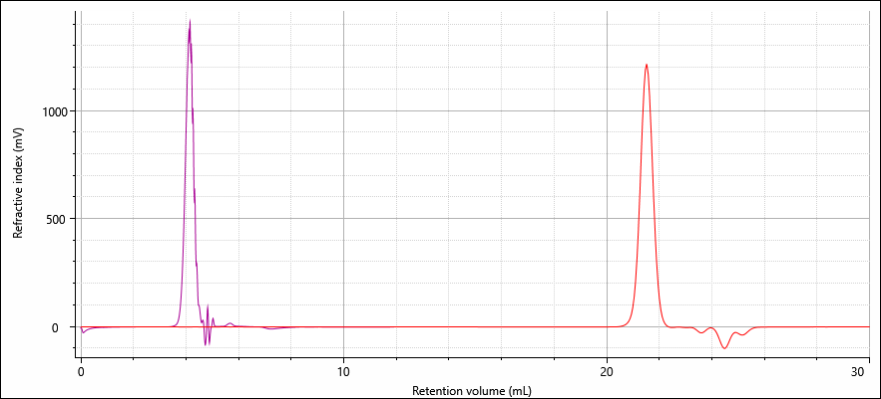
Figure 2. Overlay of refractive index signals of the low molecular weight polystyrene sample analyzed using three ACQUITY APC columns (purple) and two analytical GPC/SEC columns (red).
Closer examination of the chromatograms obtained on the ACQUITY APC-REVEAL system indicate that, in addition to a much lower retention volume (and retention time), good signal strength was acquired on all three of the refractive index, right angle light scattering, and viscometer detectors, shown in Figure 3. This combination of data allows for the calculation of absolute molecular weight, intrinsic viscosity, hydrodynamic radius, and for structural comparisons to be made using the Mark-Houwink plot.
Figure 3 shows the triple detector chromatogram of the polystyrene sample measured on the ACQUITY APC-REVEAL combination. Plotted across the top of the chromatograms is the molecular weight of the sample. As expected for a synthetic polymer sample, the molecular weight steadily decreases from the larger, earlier eluting material across the sample’s distribution to the smaller, later eluting oligomers.
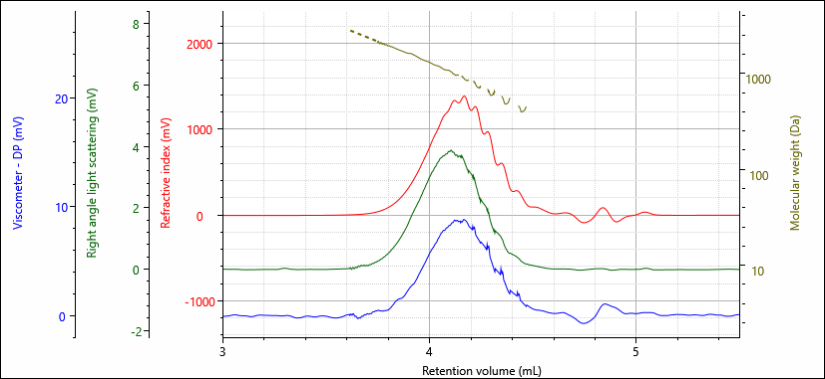
Figure 3. Triple detector chromatogram of the low molecular weight polystyrene sample; refractive index (red), right angle light scattering (green), viscometer (blue), and molecular weight (gold).
On the low molecular weight side of the sample’s peak the individual oligomers show some resolution, enough to identify several peaks with their own set of integration limits. The breaks in the molecular weight plot represent the location of those limits, which signify five individual oligomers in addition to the main portion of the distribution. The molecular characterization data for these six peaks is summarized in Table 1.

Table 1. Molecular characterization data from three injections of the low molecular weight polystyrene sample.
The molecular weights of the six fractions designated by the integration limits (calculated using a dn/dc value of 0.185 ml/g for polystyrene in THF) range from 1,260 Da down to 452 Da. Based on the molecular weight of styrene (104 Da), these fractions represent the oligomers starting with a degree of polymerization of four (n = 4) up to nine or more (n = 9+). The intrinsic viscosity and hydrodynamic radius values for each fraction were calculated as well, all with excellent precision over the three injections. The weight fraction of each oligomer is listed, with the n = 9+ fraction accounting for half of the sample and the n = 4 fraction representing only 3.56% of the sample. This demonstrates complete characterization of multiple low molecular weight species within a larger sample distribution using minimal sample, solvent, and time.
For the analysis of the polycaprolactone sample the column set was altered with the goal of improving resolution of the oligomers. The ACQUITY APC column with 450 Å pores was therefore replaced with a duplicate of the column with 45 Å pores to create a column set consisting of three 150 mm APC columns: 45, 45, and 125 Å in series. The flow rate was set to 0.5 mL/min and the column and detector temperatures were set to 35 °C. The concentration of the polycaprolactone sample was 3.18 mg/mL, of which 50 µL injections were made. Therefore, the amount of polycaprolactone introduced to the system was 159 µg, which, like the polystyrene sample, is less than the 300-500 µg used in typical GPC/SEC analyses for the same low molecular weight sample.
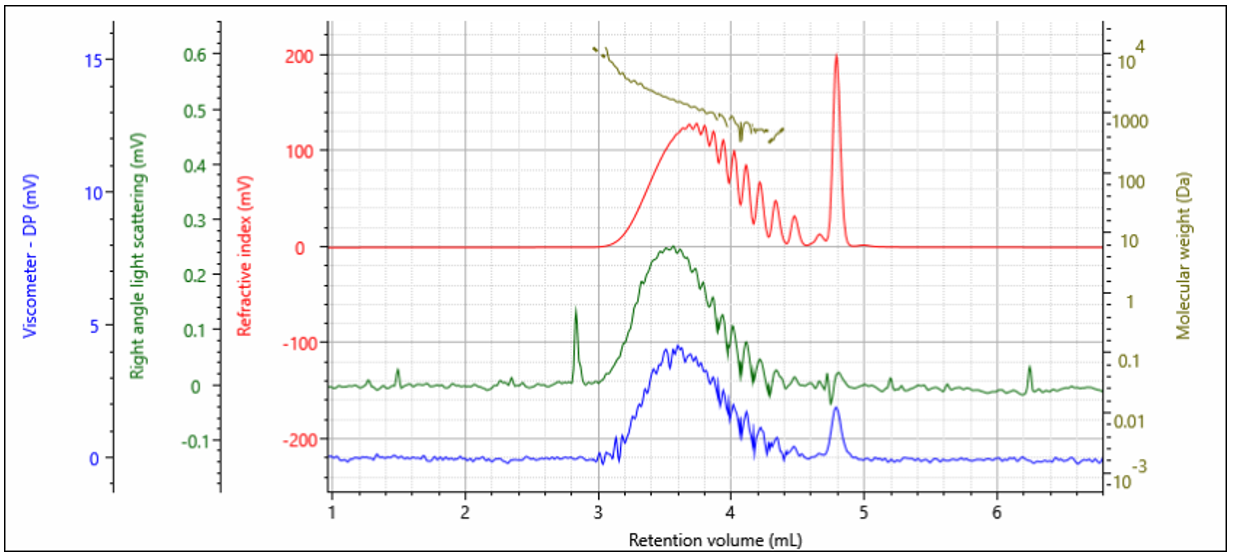
Figure 4. Triple detector chromatogram of the low molecular weight polycaprolactone sample; refractive index (red), right angle light scattering (green), viscometer (blue), and molecular weight (gold).
Similar to the polystyrene sample in Figure 3, the molecular weight plot of the polycaprolactone sample descends consistently throughout the chromatogram and is broken up into segments representing the identifiable oligomers. In addition to the main peak, five oligomeric species were selected. The molecular characterization data for these six peaks is summarized in Table 2. Again, for comparison, it was not possible to separate the various oligomers of polycaprolactone on the standard 30 cm analytical GPC/SEC columns.
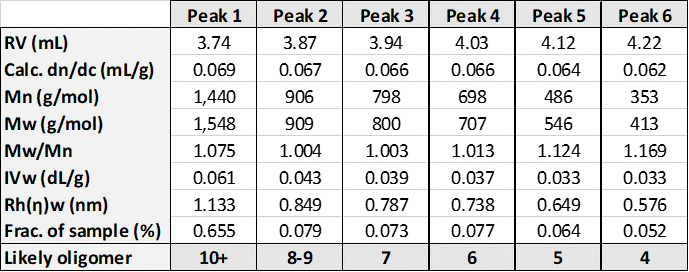
Table 2. Molecular characterization data from the low molecular weight polycaprolactone sample.
As can be seen in Table 2, the molecular weights of the six fractions of the polycaprolactone sample (calculated using a dn/dc value of 0.072 ml/g for polycaprolactone in THF) range from 1,711 Da down to 440 Da. The molecular weight of caprolactone (114 Da) is similar to that of styrene, and as such, similar fractions were observed in the sample; the oligomers starting with a degree of polymerization of four (n = 4) up to nine or more (n = 9+). While the IV values of the polycaprolactone fractions were similar to the analogous polystyrene slices, the hydrodynamic radius values of the polycaprolactones were larger than those of the polystyrene, with the largest difference in the n = 9+ segment. While this fraction represented about 50% of the polystyrene sample, it comprised about 70% of the polycaprolactone sample.
The economy and efficiency of the Waters’ ACQUITY APC combined with the powerful advanced GPC/SEC detectors of OMNISEC REVEAL allowed the complete characterization of the low molecular weight polystyrene and polycaprolactone samples. The individual oligomers of both samples could be observed and characterized separately due to the resolution of the ACQUITY APC columns and sensitivity of the OMNISEC REVEAL detectors – with standard 30 cm analytical GPC/SEC columns it is not possible to resolve the oligomers at all. The greatly reduced quantity of solvent and time required to obtain comprehensive characterization of samples using the APC-REVEAL system presents obvious benefits to both researchers and manufacturers working with polymeric materials.